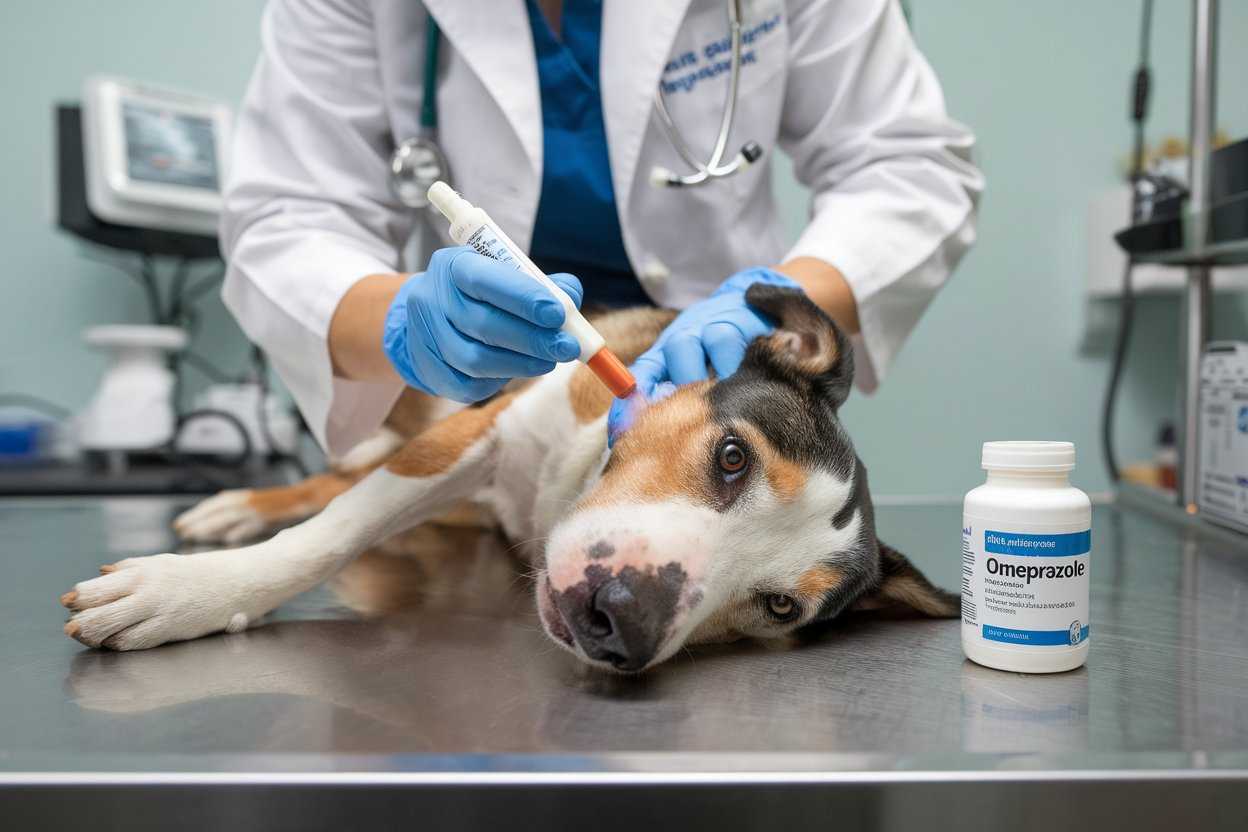When it comes to treating gastrointestinal issues in dogs, Omeprazole is often a go-to medication prescribed by veterinarians. As a proton pump inhibitor (PPI), Omeprazole helps manage conditions caused by excessive stomach acid, such as acid reflux, ulcers, and gastritis. While commonly used in human medicine, Omeprazole has also proven to be highly effective for treating dogs. This article breaks down the key aspects of Omeprazole, helping you understand its uses, benefits, side effects, and safety for your furry friend.

What is Omeprazole?
Omeprazole is a medication that belongs to the proton pump inhibitor (PPI) class, which works by reducing the production of stomach acid. Excessive stomach acid can lead to several digestive problems, including ulcers, gastroesophageal reflux disease (GERD), and inflammation of the stomach lining or esophagus. By reducing the acid, Omeprazole gives these tissues time to heal and prevents further damage.
Although Omeprazole is not specifically approved by the FDA for use in animals, it is commonly prescribed by veterinarians for dogs. The medication is available in several forms, including tablets, capsules, and liquid suspensions, making it convenient for administration based on your dog’s size and needs.
How Does Omeprazole Work in Dogs?
Omeprazole works by blocking proton pumps in the stomach lining that are responsible for producing acid. This helps reduce the acid levels in the stomach, providing relief from conditions like acid reflux, ulcers, and gastritis. For dogs suffering from these gastrointestinal problems, the reduction of acid helps alleviate symptoms such as vomiting, loss of appetite, and discomfort.
By lowering the stomach acid, Omeprazole also helps prevent acid from flowing back into the esophagus, which can cause esophagitis (inflammation of the esophagus). This is particularly helpful for dogs suffering from GERD or acid reflux.
Common Uses of Omeprazole for Dogs
Omeprazole is prescribed for several gastrointestinal conditions in dogs, primarily those involving excessive stomach acid. Some of the most common uses include:
Gastroesophageal Reflux Disease (GERD): This condition occurs when stomach acid flows backward into the esophagus, causing irritation and discomfort. Omeprazole helps reduce the acid and prevents damage to the esophagus.
Stomach and Intestinal Ulcers: Ulcers can develop due to excessive acid production, stress, or the use of certain medications like non-steroidal anti-inflammatory drugs (NSAIDs). Omeprazole reduces acid levels, allowing the ulcers to heal.
Gastritis: Inflammation of the stomach lining can cause vomiting, abdominal pain, and a loss of appetite. Omeprazole helps manage gastritis by reducing acid levels and relieving inflammation.
Esophagitis: Inflammation of the esophagus, often caused by acid reflux, can lead to discomfort in dogs. Omeprazole helps manage the condition by preventing acid from flowing into the esophagus.
Is Omeprazole Safe for Dogs?
When used under the guidance of a veterinarian, Omeprazole is considered safe for dogs. Most dogs tolerate it well, and it is effective in treating a wide range of acid-related conditions. However, as with any medication, it’s important to follow the vet’s prescribed dosage and administration guidelines.
The typical dosage for dogs ranges from 0.25 to 1 mg per pound of body weight, usually given once daily. Your vet will determine the exact dosage based on your dog’s size, weight, and the condition being treated.
Potential Side Effects of Omeprazole
Although Omeprazole is generally safe, some dogs may experience side effects. The most common side effects include:
- Gastrointestinal issues: Diarrhea, constipation, or vomiting may occur, though these are usually mild and temporary.
- Loss of appetite: Some dogs may eat less while on Omeprazole, though this typically resolves after the first few days of treatment.
- Flatulence (excess gas): Increased gas may be noticeable in some dogs.
- Lethargy: Dogs may appear more tired or less energetic while on the medication.
In rare cases, more serious side effects can occur, including allergic reactions, which may present as swelling, hives, or difficulty breathing. If you notice any severe reactions, contact your vet immediately.
Drug Interactions and Special Considerations
It’s important to inform your vet if your dog is taking any other medications or supplements. Omeprazole may interact with certain medications, including NSAIDs and antifungal drugs, which could reduce its effectiveness or increase the risk of side effects.
If your dog has any pre-existing conditions, such as liver or
kidney disease, it’s essential to discuss these with your vet before starting Omeprazole. Dogs with these conditions may require dosage adjustments or closer monitoring while on the medication.
Additionally, Omeprazole should be used with caution in pregnant or lactating dogs. While there is limited research on the effects of Omeprazole on pregnant dogs, it’s always best to consult your vet before administering any medication to a pregnant or nursing dog.
How Long Should Dogs Take Omeprazole?
The duration of treatment with Omeprazole depends on the condition being treated. For short-term issues like mild acid reflux or gastritis, treatment may last only a few weeks, while more chronic conditions such as GERD or ulcers might require longer treatment.
For long-term use, it’s crucial to regularly check in with your veterinarian to ensure the medication is still effective and not causing any long-term side effects. Some dogs with chronic conditions may need to stay on Omeprazole for an extended period, while others may only need short-term treatment.
Alternatives to Omeprazole for Dogs
While Omeprazole is a highly effective treatment for many acid-related gastrointestinal issues, it’s not the only option. Other medications, such as Famotidine (Pepcid), can also be used to reduce stomach acid in dogs. Famotidine works in a similar way to Omeprazole, but it may be preferred for certain conditions or for dogs that do not tolerate Omeprazole well.
Dietary changes can also be a critical component of managing gastrointestinal conditions in dogs. A low-fat, easily digestible diet may help reduce acid production and relieve symptoms. Always consult with your vet about the best dietary options for your dog’s specific needs.
Final Thoughts
Omeprazole is a trusted and widely used medication for managing gastrointestinal issues in dogs. Whether your dog is suffering from acid reflux, ulcers, or inflammation of the stomach lining, Omeprazole can provide relief by reducing stomach acid and allowing healing to occur.
As with any medication, it’s important to use Omeprazole under veterinary supervision. Your vet will guide you on the correct dosage, monitor your dog’s progress, and adjust the treatment plan if needed. While Omeprazole is generally safe, keeping an eye on your dog for any side effects and following up with regular vet visits will ensure your dog gets the best possible care.
By understanding how Omeprazole works and its role in treating various digestive issues, you can feel confident that you’re providing your dog with the support they need to feel better and stay healthy. If you have any concerns about your dog’s gastrointestinal health or are considering Omeprazole as a treatment option, consult your veterinarian for personalized advice. Read more







